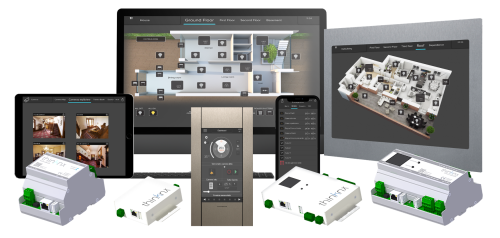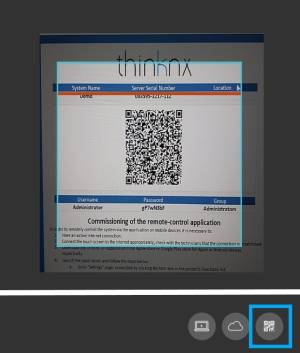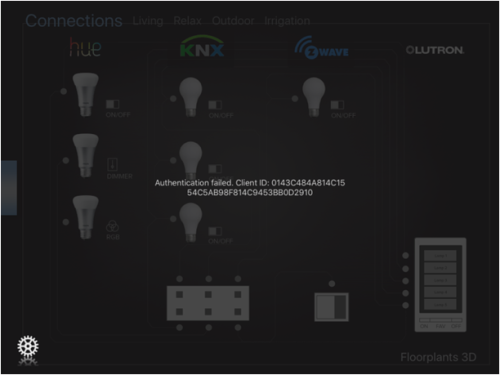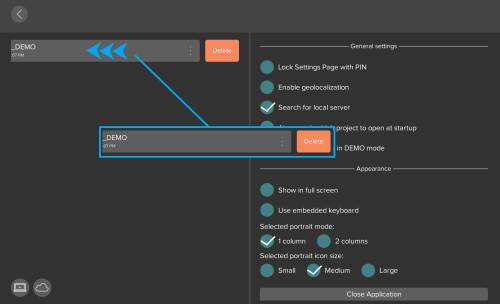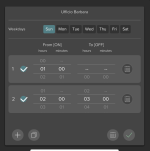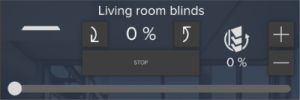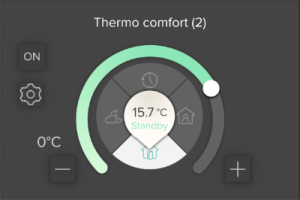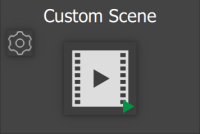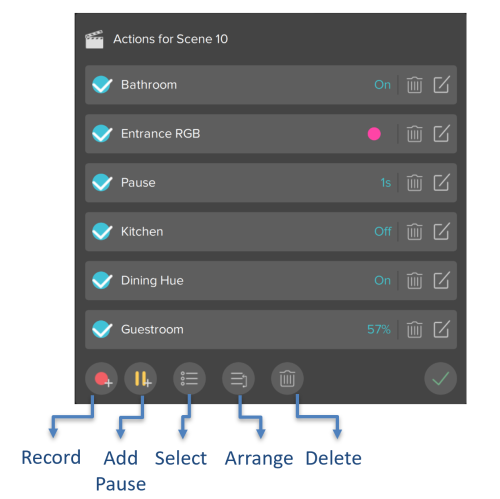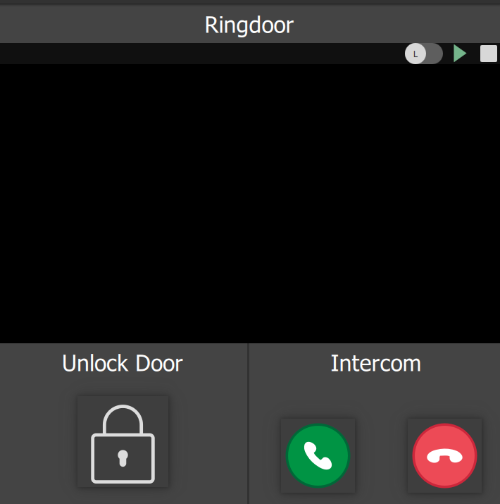−Table of Contents
End User Manual Trend Line
Click here to download the manual as PDF.
Table of Content
Introduction
This user manual is designed for end users who have installed Trend Line products as a server in their home.
It is a guide on how to use the Thinknx Trend application available on Android and iOS. Each project is different, but this guide provides an overview of the most common features, allowing the user to easily navigate through the interface.
It is assumed that the Thinknx server installed is configured by an installer, system integrator or other professional figure and that the project is already deployed on the client device
For more enquiries regarding the use of Thinknx products, our support team is available to answer tickets on www.thinknx.com/support.
General Layout
Project Interface
The project interface consists of a footer holding the main functions created by the integrator. The footer contains a large number of pages which can be changed by swiping left/right or by clicking the icon in the footer.
Project Interface
Settings Interface
To access the Settings page, on the top left you will find the setting button
The settings page consists of the projects list located to the left, and the general settings of the project located to the right. These settings will allow the user to modify the appearance, change volumes, language and even update firmware if applicable.
At the bottom of the page, multiple buttons are available to download a new project onto the client device using different methods (locally, through serial number and Cloud password, or using a QR code, if applicable).

Settings Interface
Add a Project
Adding a project can be done via two methods:
- Using the local network This can only be done in the presence of the installer or any person who is able to open the project file with the Thinknx Configurator. The URL provided by this person can be entered inside the corresponding field after clicking on the “PC” icon in the client application followed by port 5050. The project will then be downloaded using the same network as the Thinknx server.
Figure 6: Download project locally
- Using Thinknx Cloud This can be done by the client without the presence of the installer. However, the installer will have to provide the client with the correct serial number and password. The client can click on the “Cloud” icon, enter the serial number and password, and click on Download. Once the download is completed, the project will show in the list to the left.
Figure 7: Downloading project from Cloud
- using a QR Code The client can easily download the project by clicking on the “QR Code” icon and scanning a QR code shared by the installed by email/pdf. A permission should be granted to the Thinknx application to access the device's camera.
Figure 8: Downloading project by QR code
Authenticate Clients
When opening a recently added project for the very first time, an authentication process takes place between the client's device and the Thinknx server. Authentication can be done in two ways:
- Using the local network If the project has been added locally by the installer, the client will get a notification when opening the project stating that the “authentication failed”. The installer in that case must add the device ID of the client to the authenticated clients list inside the server.
Figure 9: Client Authentication 1
- Using Thinknx Cloud When the project has been downloaded from Thinknx cloud by the client, they will be prompted for a username and password the very first time they attempt to open the project. Both username and password shall be provided by the installer.
Figure 10: Client Authentication 2
Delete a Project
To delete a project, slide project name to the left and click on “Delete”.
Figure 12: Settings Interface
General Functions
Lighting
Switch
To control a simple ON/OFF light, a click on the corresponding icon will either send the toggled command instantly, or open a popup window to choose the command to be sent.
Switch
it is possible for the programmer to enable a chrono-switch, allowing the user to configure a weekly schedule for the light. The user can also copy the schedule and paste it to another one.
Switch Schedule
Dimmer
To control a dimmer, a click on the corresponding icon will open a popup allowing the user to send an ON/OFF command or choose the dimming value by moving the slider around the buttons.
Dimmer
it is possible for the programmer to enable a chrono-switch, allowing the user to configure a weekly schedule for the light. The user can also copy the schedule and paste it to another one.
Dimmer Schedule
RGB
To control an RGB light, a click on the corresponding icon will open a popup allowing the user to select the color from the color wheel and control the brightness by using the slider.
RGB
When using the RGB button, clicking on the settings icon at the bottom right corner of the popup will open an additional window. The user can save their favorite colors by clicking the “+” button. The start button will play a sequence of the saved colors. It is possible to select between random/ordered playing mode, and change the time interval between the colors during the sequence.
To delete the preset colors, simply long press on any of the presets. An X icon will show on all presets allowing the user to select the colors to be deleted.
RGB Settings
If supported, it is also possible to control the temperature of the white channel and change its brightness. To access this window, click on the top right icon in the color wheel window.
White Temperature
Motorization
Shutter
A shutter icon consists of a Horizontal slider allowing the user to change the shutter height value. The user can also click on the Up/Down buttons on the right of the widget.
Shutter
Blind
For blinds, the icon will have extra buttons to control the rotation of the louvres to allow more or less light into the room. The user can either operate the louvres using the slider or the buttons.
Blind
Climate
HVAC
An HVAC widget, holds the below functions:
- An On/Off button at the top right corner to control the machine.
- A slider to change the setpoint of the room.
- An indicator of the setpoint value at the center.
- Four buttons around the indicator to change the modality between Heat, Cool, Dry, Fan.
HVAC
Thermo Comfort
A Thermo Comfort icon can be one of two types:
- Type 1 Control of the setpoint is done manually using the slider or the chrono thermostat schedule.
- Type 2 Control of the setpoint is done by selecting between Comfort, Standby, Night and Frost protection mode, or the chrono thermostat schedule.
Type 1
- Read the actual room temperature on the bottom left corner of the widget.
- Change the setpoint by selecting the manual mode (hand icon) and using the slider.
- If chrono-thermostat is enabled, click on settings to program the daily temperature settings per hour.
Type 2
- Read the actual room temperature on the top left corner of the popup.
- Change the setpoint by selecting the desired mode (Comfort, Standby, Night, Frost Protection) or using the slider.
- If chrono-thermostat is enabled, click on settings to program the daily mode settings per hour.
Scene
When accessing the Scene icon, the user is able to:
- Record actions in the scene.
- Access the actions list recorded.
- Rename the scene.
- Launch recorded scene.
Scene
When recording a scene, a red frame will appear around the interface allowing the user to browse through the pages and click on the buttons to be included in the scene.
If the users do not wish to send the commands to the bus while recording, they can click on the bottom right corner icon to enable/disable this feature.
Clicking on the bottom left corner of the screen will save and exit the recording mode.
Scene Recording
When clicking the Actions button, it is possible to:
- Record additional actions in the scene.
- Add a pause in between actions.
- Select multiple actions.
- Re-arrange the order of the actions.
- Delete one or more actions.
When recording additional actions, the red frame will appear again around the interface to allow the user to browse through the pages and click on the buttons to be included in the scene. Once finished, the user should click on the bottom left button (red circle) to save the changes.
Scene Actions
Intercom
When using the intercom, regardless of the door unit installed, the user is able to:
- Receive a call on Thinknx Envision or Thinknx application whenever the door rings.
- Answer/Reject call.
- View the camera if available.
- Open door.
Figure 35: Intercom
When accessing the Settings page, it is possible to:
- Choose a ringtone.
- Change microphone volume.
- Enable/disable the use of ringtone in project.
Figure 36: Intercom Settings
